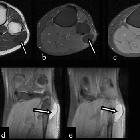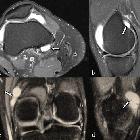ganglion cyst



































Ganglion cysts are non-malignant cystic masses that occur in association with musculoskeletal structures. They are the most common soft tissue mass in the hand and wrist.
Terminology
Ganglion cysts are sometimes also simply referred to as ganglia or a ganglion, but should not be confused with the anatomical term ganglion.
Epidemiology
They occur more commonly in young women (especially in and around the hand) .
Clinical presentation
They can cause a myriad of symptoms dependent on location due to mass effect on adjacent structures, and these are best discussed under location specific subsites. A proportion of patients have a history of trauma.
Pathology
The etiology of ganglion cysts is unclear and are generally thought to result from myxoid degeneration of the connective tissue associated with joint capsules and tendon sheaths . They may represent sequelae of synovial herniations or coalescence of small degenerative cysts arising from the tendon sheath, joint capsule or bursae. Typically, they are attached to the underlying joint capsule or tendon sheath .
Some ganglion cysts can occur in post-traumatic and post surgical situations .
Histology
Histologically, ganglia have a thin connective tissue capsule, but no true synovial lining, and contain mucinous material filled with gelatinous fluid rich in hyaluronic acid and other mucopolysaccharides .
Location
They can occur within
- muscles: intramuscular ganglion cyst
- menisci: intrameniscal ganglion cyst
- tendons: intratendinous ganglion cyst
- bones: intraosseous ganglion cyst
According to anatomy
They can occur in numerous locations but most commonly (70-80% of cases) occur in relation to the hand or wrist (ganglion cysts of the hand and wrist) in this location, notable specific subsites include :
- dorsum of the wrist: ~60% of all hand ganglion cysts
- volar aspect of the wrist: ~20%
- flexor tendon sheath: ~10%
- in association with the distal interphalangeal joint: ~10%
Other notable locations include:
- knee, e.g. ACL ganglion cyst
- spinoglenoid notch: spinoglenoid notch ganglion cyst
- ankle: foot
Classification
There are many ways of classifying ganglion cysts.
In relation to structure, e.g. bone
- within bone: intraosseous ganglion cyst
- adjacent to the bone: periosteal ganglion cyst - rare and may occur more frequently in males
- away from bone: soft tissue ganglion cyst
In relation to structure, e.g. joint
- within the joint: intra-articular ganglion cyst
- adjacent to a joint: juxta-articular ganglion cyst
In relation to structure, e.g. nerve
- within a peripheral nerve: intraneural ganglion cyst
Radiographic features
Ultrasound
The vast majority are anechoic to hypoechoic on ultrasound and have well-defined margins . Many demonstrate internal septations as well as acoustic enhancement .
MRI
Usually seen as a unilocular or multilocular rounded or lobular fluid signal mass, adjacent to a joint or tendon sheath. Very small cysts may simulate a small effusion, but a clue to the diagnosis is the paucity of fluid in the remainder of the joint and the focal nature of the fluid. Periosteal bone formation may be visible.
Signal characteristics include:
- T1: typically ganglia are low signal although high proteinaceous content or hemorrhage may result in lesions appearing isointense or hyperintense on T1 weighted images
- T2/STIR: typically high signal
Ruptured cysts
Ruptured cysts are often irregularly delineated and show pericapsular edema on T2 weighted image . The cyst itself may show diffuse enhancement after intravenous administration of gadolinium contrast, but there is often an absence of enhancement of the pericapsular soft tissue edema.
History and etymology
Ganglion cysts are thought to be first described by Hippocrates as ‘‘knots of tissue containing mucoid flesh’’.
Differential diagnosis
General imaging differential considerations include:
- synovial cyst: these have a synovial lining, and although histologically distinct from ganglia, are indistinguishable on imaging
Siehe auch:
und weiter:
- Epidermoidzyste
- intraossäres Ganglion
- Ganglion des hinteren Kreuzbandes
- spinale Arachnoidalzyste
- Ganglion des vorderen Kreuzbandes
- Riesenzelltumor der Sehnenscheiden
- Tarsaltunnelsyndrom
- anterior hip pain
- kutane Metastasen
- Ganglion
- calcaneal lesions (mnemonic)
- medial meniscal cyst
- ganglion cyst in the neck
- periosteal ganglion
- tibial periosteal ganglion
- Ganglionzysten der Hand und des Handgelenks
- peripherer Nervenschaden durch Ganglion
- verkalkte Ganglionzyste
- ganglion cyst - knee
- pisotriquetral cyst
- ganglia of the wrist

 Assoziationen und Differentialdiagnosen zu Ganglion (Überbein):
Assoziationen und Differentialdiagnosen zu Ganglion (Überbein):

